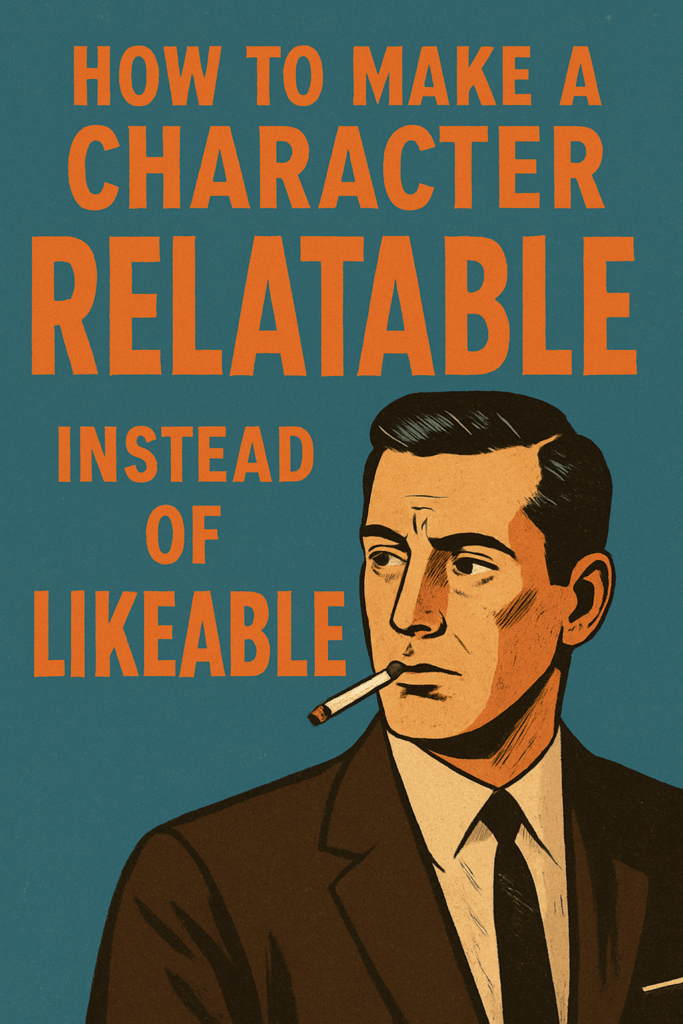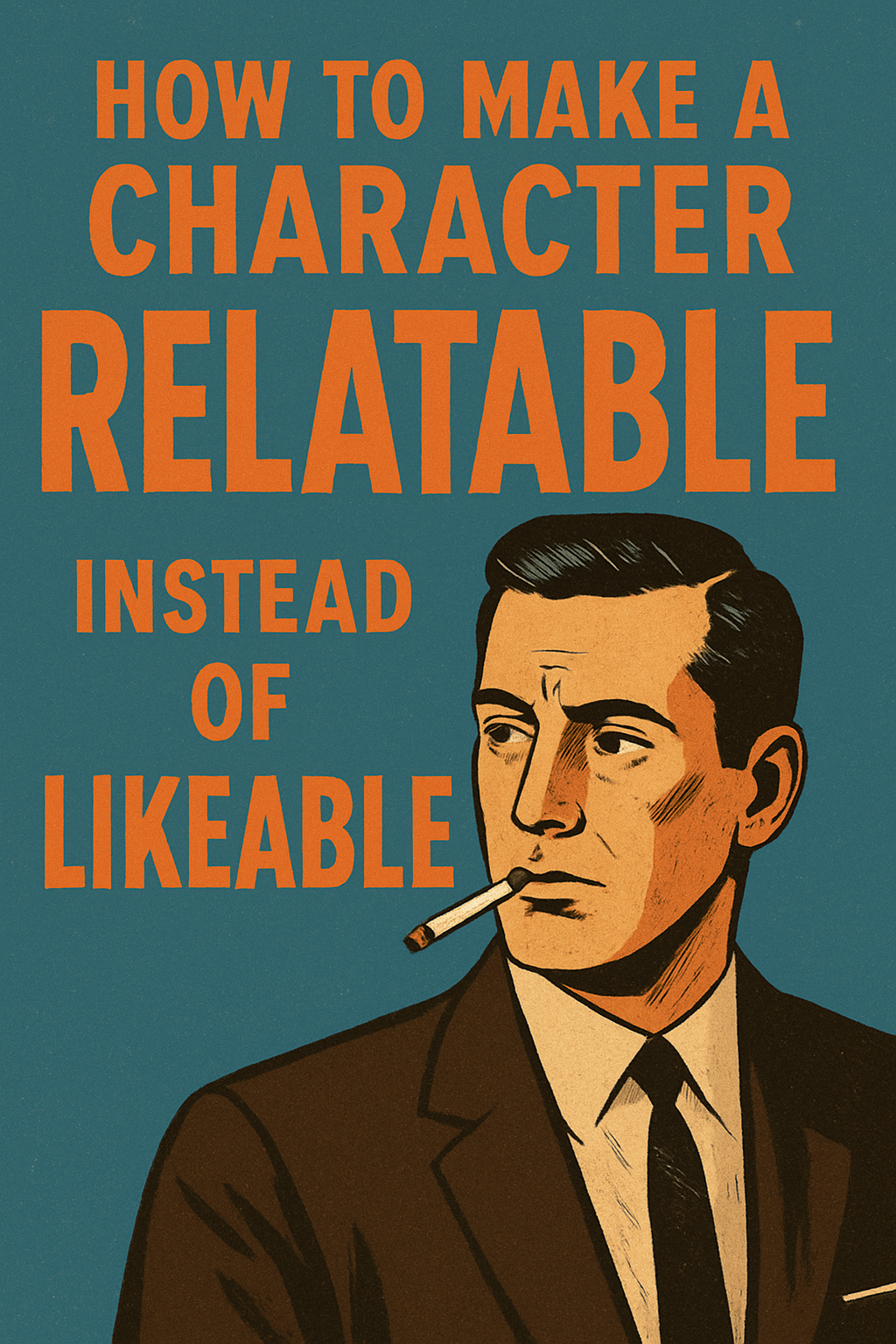How to Write a Relatable Character for Screenwriters

The next person who tells me a character needs to be “likeable” gets a punch in the face.
“We need a reason to like your heroine; maybe you should give her a baby.”
“Your hero should Save the Cat in the first ten pages.”
“I kept reading, but I just keep asking why I should like these people.”
Now, it’s easy to be enraged by comments like this, but I have to go back to my pacifist roots and realize that these are the comments of people who are non-writers and they feel it necessary to flex by taking a great big Should all over my work.
It’s not their fault; they don’t know any better. It’s high time that we educate the Should out of them.
You see, the point here is not that a character needs to be likeable. There are plenty of unlikeable characters in the world, from Tony Soprano to Michael Corleone to Fleabag. The reason that these characters continue to compel is not that they’re likeable, even if they exhibit rare moments of decency.
Rather, it’s because we relate to the characters. Likeable characters are boring. They never do anything unlikeable, because then, well, they might not be likeable. Get it?
What we need, obviously, is relatable characters. We want people who have the same flaws and hangups that we have. We want characters who generally try to do good things, but perhaps fail at this more than they succeed.
In short, we need characters in whom we can see reflections of ourselves. And I don’t know about you, but I find it hard to be a good person all of the time.
Frankly, it’s fucking exhausting to try.
Bearing that in mind, it’s a comfort to see a character who occasionally acts a bit wrong.
Because we all do.
The Anti-Anti-Hero or: The Superman Paradox
So I’m not a massive fan of the term “anti-hero.”
What does that even mean? Does the hero always have to be right and morally justified?
This is the Superman Paradox: the fundamental problem with nearly every Superman narrative for the past 80+ years: the man doesn’t have any actual flaws, so what the hell is the point of the story? It takes some clever story finagling to make this work, which is why most of the Superman films kind of suck.
(For good ones, see the first Christopher Reeve version or James Gunn’s latest.)
Even Charlie Brown experiences frustration, has demonstrable flaws–for example telling Lucy that girls don’t belong on the football field–and then looks like an idiot when Lucy yoinks the football out from under his foot.
It’s shockingly obvious that even the most milquetoast characters have real issues that need to be dealt with. George McFly’s milquetoast nature is the crux of the whole issue in Back to the Future, if you think about it. The fact that he’s a peeping tom (remember that part?) just makes him more interesting as a character.
Now that doesn’t mean your character needs to be a sexist or a peeping tom (but hey, if it works…). What it does mean is that your character probably needs some characteristic that is antithetical to her goal, usually one she simply can’t help herself from doing.
So feel free to inject a little bad, a little nasty into your characters. At the very least, it’ll liven things up. There’s no reason that the protagonist needs to be a hero, or that a flawed protagonist needs to be an anti-hero.
The measure of a protagonist, then, is how much we want to follow this person on her journey: again, how relatable we find her.
The Writing Cheat that Spawned an Industry
Let’s go back for a moment to the original meaning of Saving the Cat.
This refers to a situation early in the film where a character does something nice–likely somewhat out of character–so that we know this person has a decent side even if the person turns out to be a douche for the rest of the film.
(I’ll freely admit that Saving the Cat is an improvement on the old Hollywood trick of simply making a character a douche throughout the film and relying on a magnetic actor’s vibe to carry the day. McQueen, Mitchum, Sterling Hayden. Not every film, of course, but too many leaned into charisma because of poor writing in the first place.)
The problem is that Saving the Cat doesn’t really make a character either likeable or, crucially, relatable.
There are a lot of different ways to deal with this; you’ll find a lot of scenes at the beginning of a film where people simply inject a random reason for a person to do something nice. After this point, the character then runs off and is basically a douche for the rest of the film. Just look at basic Netflix filler content–e.g. Maya Hawke’s character in Do Revenge–for this one.
Painting Your Character as an Underdog
Another, more solid variant of this is the Underdog.
Given that most people naturally want to sympathize with the downtrodden, it does work–at least to a degree–to make a character an underdog at the beginning of a film. That’s sort of the whole point of Charlie Brown.
The problem is that sometimes we never really get any indication of why we ought to relate to the character in the first place. You get a weaker version of this in John Carpenter’s Christine, at least given that Arnie ultimately turns out to be a villain.
You find a stronger version with Joe in Sunset Boulevard. We really have no reason to like Joe except that he’s been consistently shat upon and, honestly, by the time he gets to Norma’s place he’s simply less weird than everyone surrounding him. He becomes our avatar by virtue of the fact that he’s halfway normal, even if Joe is a broke, scheming deadbeat.
How to Make a Character Relatable
The Underdog argument gets us part of the way there.
In truth, we empathize with characters when we see vulnerability or weakness, competence or humor. Or, of course, some combination thereof.
Starting off The Sopranos in the shrink’s office was a masterstroke. Even if a character acts nasty, as Tony certainly does from time to time, we see him talking being vulnerable and almost whimsical when talking about the ducks on the swimming pool.
And of course without Tony, we would never have Don Draper, who might just be the archetypal relatable, yet unlikeable character.
(Quick Aside on Star Power)
Before you assume that Jon Hamm’s presence or star power is the true reason behind Don’s relatability, I urge you to watch interviews with Hamm himself or watch him in any number of other roles.
Hamm is an excellent character actor who happens to be blessed with Leading Man looks. He could hardly be farther in personality from brooding Don. Even if embodying Don Draper makes Jon Hamm magnetic, we must admit that this is a function of the character himself–who was originally on the page, of course–rather than nothing more than Hamm’s swagger.
This is not to knock Hamm’s work as Don Draper; it is merely to point out that the character is a function of the writing as well as the man.
Don Draper’s Relatability
We can see how Don’s relatability ticks simply by reading the pilot episode of Mad Men, entitled “Smoke Gets in Your Eyes.”
I would be remiss not to note that Don Draper does something eminently decent in the first scene: he is kind to the black porter, while the porter’s boss is a douche. In a sense, this is Saving the Cat. However, writer Matthew Weiner doesn’t stop here.
Weiner goes on to describe a litany of reasons that we can relate to Don. There are so many in this episode that it’s actually easiest simply to list them. Here we go…
Turning Points to Paint Don Draper’s Character
This is a list of the turning points that show us Don Draper’s complex, yet compelling character–all directly drawn from Matthew Weiner’s pilot script for Mad Men, “Smoke Gets in Your Eyes.”
The items are presented in roughly chronological order. I’ve added a note at each point to describe what this illustrates for the reader/viewer.
- Don expresses his frustration and vulnerability about the Lucky Strike account to Midge, his partner. This guy has a hip bohemian girlfriend. Maybe he’s not all boring grey suit after all.
- Don bats away Roger’s fairly racist suggestion about whether there are any Jewish employees at Sterling Cooper by making anodyne jokes; these jokes might not fare well by today’s standards, but they are relatively inoffensive in context–particularly compared to Roger’s initial suggestion. He sees Roger’s inappropriateness and de-escalates.
- Don, in the same scene, has his shirt buttoned wrong and has to fix it. He isn’t perfect; we all do this from time to time.
- Don asks Peggy upon first meeting her to stall Pete. That is, Don doesn’t like Pete and doesn’t want to deal with him–he’s not too cool to be irritated by the little prick.
- After this, Don calls Peggy by name despite having just met her–and having been hijacked by Pete. He is conscientious.
- Don fumbles by mistaking the kid from the mailroom (the one Jewish person Roger found) for the Mencken representative; he assumed it would be a man, not the beautiful Rachel. Don has made a fool of himself in front of an important client.
- Don later blows up and storms out with a dismissive, sexist comment when Rachel rejects his idea of introducing coupons. Balance vulnerability and humiliation with a bit of assholery. This dick move, notably, is the Midpoint of the episode.
- Don banters and teases the overtly lesbian-coded research director and the overtly gay-coded art director. Don is hip to what they believe are secrets, and doesn’t look down on them for it. He’s a sophisticated guy for 1960.
- Don, despite having come up with nothing for the Lucky Strike account, pulls a rabbit out of his hat after Pete fumbles a different idea; Don takes a figurative three-pointer as the clock runs out, and swishes. This guy is a total badass at his job.
- Later on, Don rebuffs Peggy’s come-on. In an era where men sleeping with their secretaries was so common as to be cliche, we see that Don won’t be bound by such trite writing.
- Don later meets Rachel to apologize. A man in 1960 apologizing for, well, anything? This guy is a fascinating piece of work. (He also gets in the classic zinger that love was invented by men like him “to sell nylons.”)
- And then we see him go home on the train to his fucking wife and children. Is everything we know about Don a lie? Perhaps, but by this point we’re along for the ride.
By this point, we have seen the good and the bad, the ups and the downs, the vulnerable and the callous. Don is an incredibly well-formed person. He is not just the sort of person you’d want to be friends with (and, really, you probably wouldn’t), he is the sort of person you see yourself in.
Conclusion
Don is an enigma, but he’s a very human enigma. We want to know more because we want to know what makes someone so fascinating–and so demonstrably awful in certain ways–so relatable.
Watch how the writing–and it’s all in the script–plays with the irony that he 1) is progressive compared to his repressive era; and 2) that he is often surprisingly decent, but occasionally overwhelmingly terrible.
Don Draper sticks in the mind because he can at once be an underdog–he’s screwed with this new Lucky Strike pitch. He has real issues with women. He has objective ability as a copywriter and pitch man. He has–at least in certain domains–a strong moral center.
Then he confounds us by being a real douche: he lashes out at Rachel, whom he’s clearly attracted to, essentially just because she’s a woman. So he’s more stuck in his time than we thought.
And, as a cherry on top, we realize that–unbeknownst to us–he has, the whole time, been betraying his entire family on Long Island with Midge, Rachel, and whomever else he might take a fancy to in the future.
As such, Don’s relatability comes from a blend of flaws, contradictions, charm, skill–and the occasionally shitty behavior just to keep things interesting.
Like all of us, even if we only wish we could be so extreme as Don.
Exercises to Write a Relatable Character
With all this in mind, let’s try a few exercises.
- The Flawed Reaction Exercise
- Write a scene where your protagonist overreacts, says the wrong thing, or embarrasses themselves.
- Show the flaw without softening it — then make sure the audience still understands why they reacted that way.
- Write a scene where your protagonist overreacts, says the wrong thing, or embarrasses themselves.
- The Unexpected Kindness Exercise
- Give your relatable character a small, human gesture of care toward someone socially beneath them, an enemy, or a stranger.
- Keep it small, not grandiose — audiences relate more to ordinary kindness than to saint-like gestures.
- Give your relatable character a small, human gesture of care toward someone socially beneath them, an enemy, or a stranger.
- The Contradiction Exercise
- List three positive traits of your protagonist.
- For each, design a scene where the same trait becomes a weakness or causes trouble.
- Example: confidence → arrogance; intelligence → paralysis by analysis.
- List three positive traits of your protagonist.

